Galaxies
The Building Blocks of the Universe
Galaxies provide some of the most stirring sights outside the solar system, but it takes photography to reveal their majesty. While some structure of the brightest spiral galaxies can be glimpsed visually through large telescopes, there is simply no substitute for long exposure imaging.
The remoteness of these objects and the sheer numbers of them spread throughout the cosmos can be calculated but hardly comprehended. Whether photons from these magnificent structures reach the human eye or that of the camera, the Carroll telescope becomes a literal time machine, offering views not of “what is, ” but “what was.“
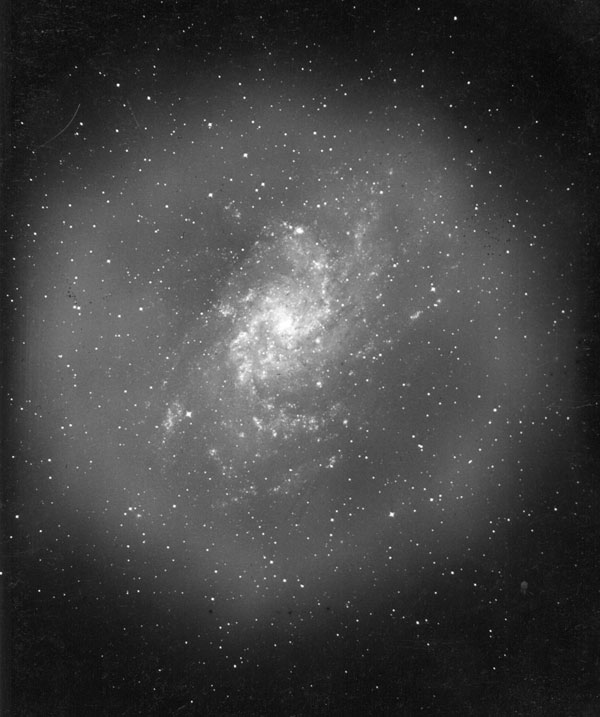
M33 (NGC 598) The Great Triangulum Galaxy
Roy Ensign and George Moyen
This is an image of the famous large spiral in Triangulum taken on October 7, 1963 through the 30-inch Carroll telescope's Newtonian focus. Using spectroscopic-sensitive Kodak 103aO film, Ensign and Moyen opted for a 20 minute exposure. Their capture recorded several bright knots in the galaxy's arms along with several dust lanes.
This is a digitized version of the original 4x5-inch negative showing that the fully-illuminated image circle for the Carroll telescope was four inches. This resulted in a field of view of 1.3 degrees in the telescope's f/6 configuration, more than twice the diameter of the full moon.
A brief video discussing "vignetting," the optical aberration seen here, can be found on SRO's YouTube Channel.

M33 (NGC 598) The Great Triangulum Galaxy
Roy Ensign and George Moyen
This is an image of the famous large spiral in Triangulum taken on October 7, 1963 through the 30-inch Carroll telescope's Newtonian focus. Using spectroscopic-sensitive Kodak 103aO film, Ensign and Moyen opted for a 20 minute exposure. Their capture recorded several bright knots in the galaxy's arms along with several dust lanes.
This is a digitized version of the original 4x5-inch negative showing that the fully-illuminated image circle for the Carroll telescope was four inches. This resulted in a field of view of 1.3 degrees in the telescope's f/6 configuration, more than twice the diameter of the full moon.
A brief video discussing "vignetting," the optical aberration seen here, can be found on SRO's YouTube Channel.
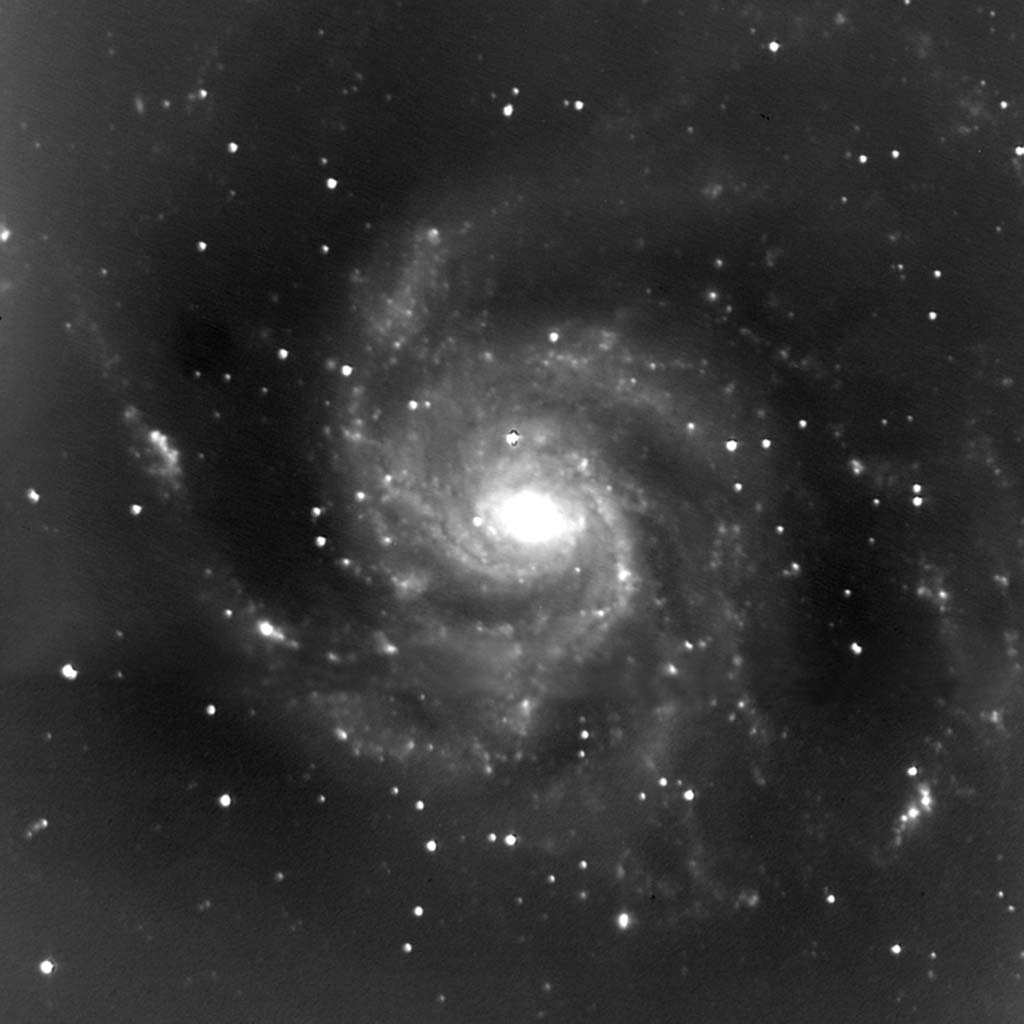
M101 (NGC 5457), the "Pinwheel"
Uncertain
M101 is a large, open-armed "island universe" found not far from the well-known double star Mizar in the handle of the Big Dipper, that familiar asterism formed from a bright subset of stars in Ursa Major. In this undocumented photo, the Carroll 30-inch telescope reveals structure away from the nucleus which, as is typically the case, is overexposed in order to capture fainter details in outlying areas.
The galaxy was discovered in 1781 by Pierre Méchain, a contemporary of comet hunter Charles Messier, who notified the latter of his find. Messier then added it to his catalog of "fixed" objects.
The relatively small telescopes that these astronomers used, long before the means of photography, yielded only smudges of light from distant objects like M101 - and from fortuitous comets, a kind of grail for astronomers needing patronage through notoriety. The fuzzy appearance of comets, so much like deep sky objects in those scopes, could be confounding when a new suspect was spotted. For this reason, Messier began the eponymous catalog of objects known to be fixed in the heavens which helped to confirm - or discount - potential comet discoveries.
Of course, either man knew the true nature of this object and would have been astounded at the reality: a *galaxy twice the size of our own Milky Way and some 21 million light years distant. Furthermore, in a bit of strange irony, just because galaxies like M101 seem immobile doesn't mean they must appear static - unchanging. To prove the point, a bright supernova named SN 2023ixf flared in 2023 (hence the nomenclature) and resulted in the formation of either a black hole or neutron star. Such entities were first theorized during the time of Messier and Méchain but proof would only come much, much later.
*During the mid 1700s, the concept of a galaxy was only beginning to emerge. This was largely based on studies of star distribution density which compared the Milky Way to other parts of the sky, these by William Herschel and later, his son John. A seminal publication by fellow English astronomer Thomas Wright in 1750 proposed that our solar system was one of many in a flat disk of stars. A few years later, philosopher Immanuel Kant suggested that many nebulous objects were in fact, constructs like our own galaxy. Despite these insightful speculations, in terms of scale, the dimension of such objects or the distances to them could hardly be imagined.

M101 (NGC 5457), the "Pinwheel"
Uncertain
M101 is a large, open-armed "island universe" found not far from the well-known double star Mizar in the handle of the Big Dipper, that familiar asterism formed from a bright subset of stars in Ursa Major. In this undocumented photo, the Carroll 30-inch telescope reveals structure away from the nucleus which, as is typically the case, is overexposed in order to capture fainter details in outlying areas.
The galaxy was discovered in 1781 by Pierre Méchain, a contemporary of comet hunter Charles Messier, who notified the latter of his find. Messier then added it to his catalog of "fixed" objects.
The relatively small telescopes that these astronomers used, long before the means of photography, yielded only smudges of light from distant objects like M101 - and from fortuitous comets, a kind of grail for astronomers needing patronage through notoriety. The fuzzy appearance of comets, so much like deep sky objects in those scopes, could be confounding when a new suspect was spotted. For this reason, Messier began the eponymous catalog of objects known to be fixed in the heavens which helped to confirm - or discount - potential comet discoveries.
Of course, either man knew the true nature of this object and would have been astounded at the reality: a *galaxy twice the size of our own Milky Way and some 21 million light years distant. Furthermore, in a bit of strange irony, just because galaxies like M101 seem immobile doesn't mean they must appear static - unchanging. To prove the point, a bright supernova named SN 2023ixf flared in 2023 (hence the nomenclature) and resulted in the formation of either a black hole or neutron star. Such entities were first theorized during the time of Messier and Méchain but proof would only come much, much later.
*During the mid 1700s, the concept of a galaxy was only beginning to emerge. This was largely based on studies of star distribution density which compared the Milky Way to other parts of the sky, these by William Herschel and later, his son John. A seminal publication by fellow English astronomer Thomas Wright in 1750 proposed that our solar system was one of many in a flat disk of stars. A few years later, philosopher Immanuel Kant suggested that many nebulous objects were in fact, constructs like our own galaxy. Despite these insightful speculations, in terms of scale, the dimension of such objects or the distances to them could hardly be imagined.
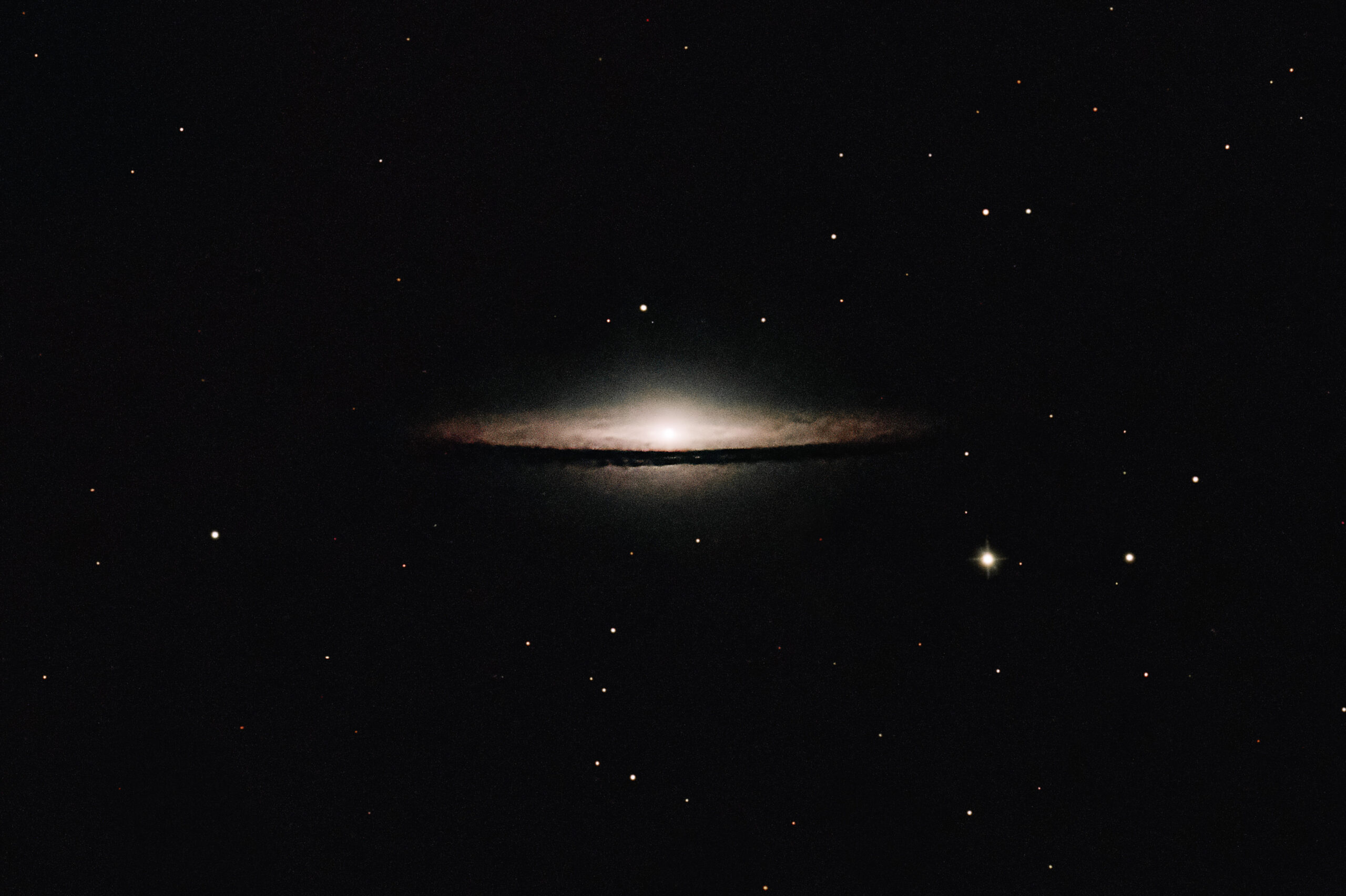
M104 (NGC 5494), the "Sombrero"
Ryan Kinnett with Scott Popjes
M104 is one of the most widely photographed galaxies and is classified as "peculiar," a kind of catch-all designation when its visual structure isn't clearly spiral or elliptical. The prominent dust lane seen "edge-on" is also visible through the eyepiece of telescopes far smaller than the Carroll reflector used to capture this image.
The wide, dark feature gives rise to the "Sombrero" description for which the galaxy is familiarly known. Appropriately enough, at least for SRO observers, this object is best viewed when the telescope is pointed generally south, toward Mexico.
This fifteen minute exposure using a CMOS camera was a test of sorts and not the result of a dedicated effort to image the galaxy. Nevertheless, it shows the extraordinary reach of a research telescope outfitted with a modern electronic camera and aided by image processing software.

M104 (NGC 5494), the "Sombrero"
Ryan Kinnett with Scott Popjes
M104 is one of the most widely photographed galaxies and is classified as "peculiar," a kind of catch-all designation when its visual structure isn't clearly spiral or elliptical. The prominent dust lane seen "edge-on" is also visible through the eyepiece of telescopes far smaller than the Carroll reflector used to capture this image.
The wide, dark feature gives rise to the "Sombrero" description for which the galaxy is familiarly known. Appropriately enough, at least for SRO observers, this object is best viewed when the telescope is pointed generally south, toward Mexico.
This fifteen minute exposure using a CMOS camera was a test of sorts and not the result of a dedicated effort to image the galaxy. Nevertheless, it shows the extraordinary reach of a research telescope outfitted with a modern electronic camera and aided by image processing software.
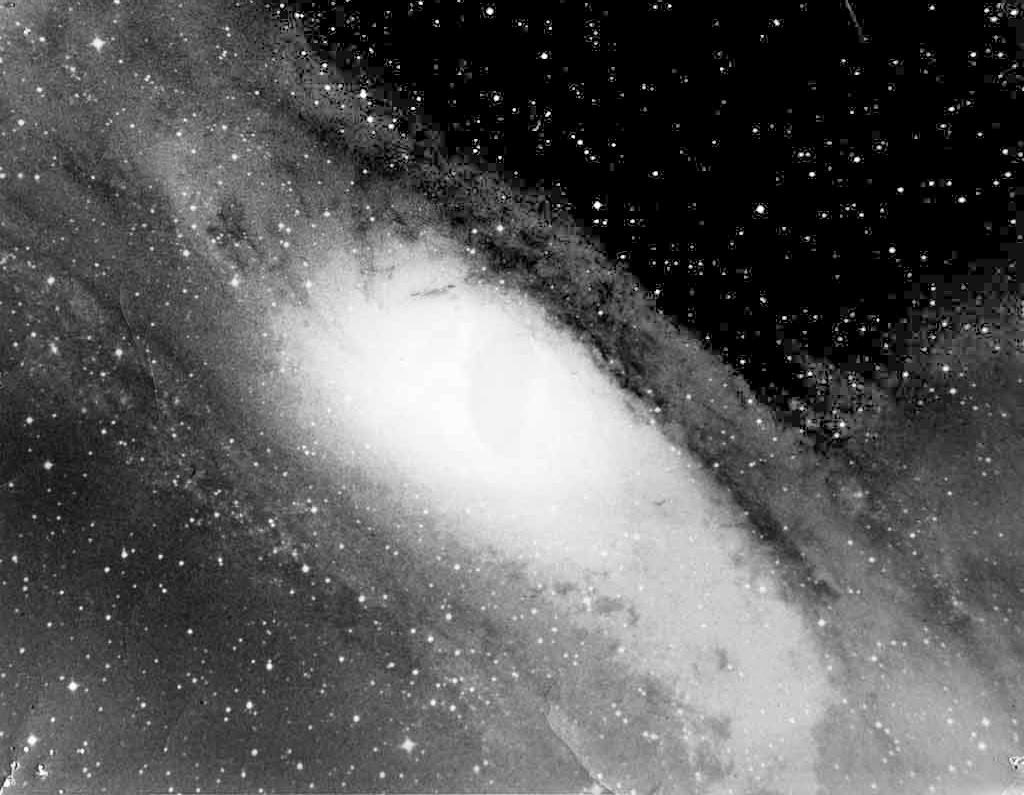
M31 (NGC 224) "Andromeda"
Uncertain
The nearest and brightest galaxy in the skies of the northern hemisphere, M31 spans significant angular dimensions. Much too large to be entirely captured in one shot, even in the "wide-field" native f/6 configuration of the Carroll reflector, the nuclear region of this object takes up much of the frame with several prominent dust lanes visible.
The photo shown here was most likely recorded in the early morning hours of May 9, 1973. It was taken by college students completing coursework at Stony Ridge Observatory,
just a few miles and half century removed from where another academic pursuit, one of singular importance, was being conducted at nearby Mt Wilson.
There Edwin Hubble had obtained historic images of the galaxy and with them, began to reveal secrets that M31 held suggesting the true scale of the universe. On photographic plates made through the 100-inch Hooker telescope, then the world's largest, he identified within the galaxy's arms Cephid variable stars. This class of suns was well-known for the exquisite relationship locking the period of variability to the star's absolute magnitude - it's "true" brightness.
Armed with such knowledge, Hubble could calculate the distance required to correlate the difference in magnitudes, work which fixed the galaxy far outside the confines of our own. In so doing he settled, once and for all, the "Great Debate concerning spiral nebulae." As Heber Curtis had argued, these objects were galaxies in their own right and not structures held within our own Milky Way.
Today, we know that M31 lies about 2.2 million light years from us, a relative neighbor and much closer than the edge of the observable universe which is estimated to be about 6000 times more distant. By the time you read this sentence, that far horizon is incrementally further still, for the universe is expanding and, according to current research, accelerating as it does.

M31 (NGC 224) "Andromeda"
Uncertain
The nearest and brightest galaxy in the skies of the northern hemisphere, M31 spans significant angular dimensions. Much too large to be entirely captured in one shot, even in the "wide-field" native f/6 configuration of the Carroll reflector, the nuclear region of this object takes up much of the frame with several prominent dust lanes visible.
The photo shown here was most likely recorded in the early morning hours of May 9, 1973. It was taken by college students completing coursework at Stony Ridge Observatory,
just a few miles and half century removed from where another academic pursuit, one of singular importance, was being conducted at nearby Mt Wilson.
There Edwin Hubble had obtained historic images of the galaxy and with them, began to reveal secrets that M31 held suggesting the true scale of the universe. On photographic plates made through the 100-inch Hooker telescope, then the world's largest, he identified within the galaxy's arms Cephid variable stars. This class of suns was well-known for the exquisite relationship locking the period of variability to the star's absolute magnitude - it's "true" brightness.
Armed with such knowledge, Hubble could calculate the distance required to correlate the difference in magnitudes, work which fixed the galaxy far outside the confines of our own. In so doing he settled, once and for all, the "Great Debate concerning spiral nebulae." As Heber Curtis had argued, these objects were galaxies in their own right and not structures held within our own Milky Way.
Today, we know that M31 lies about 2.2 million light years from us, a relative neighbor and much closer than the edge of the observable universe which is estimated to be about 6000 times more distant. By the time you read this sentence, that far horizon is incrementally further still, for the universe is expanding and, according to current research, accelerating as it does.
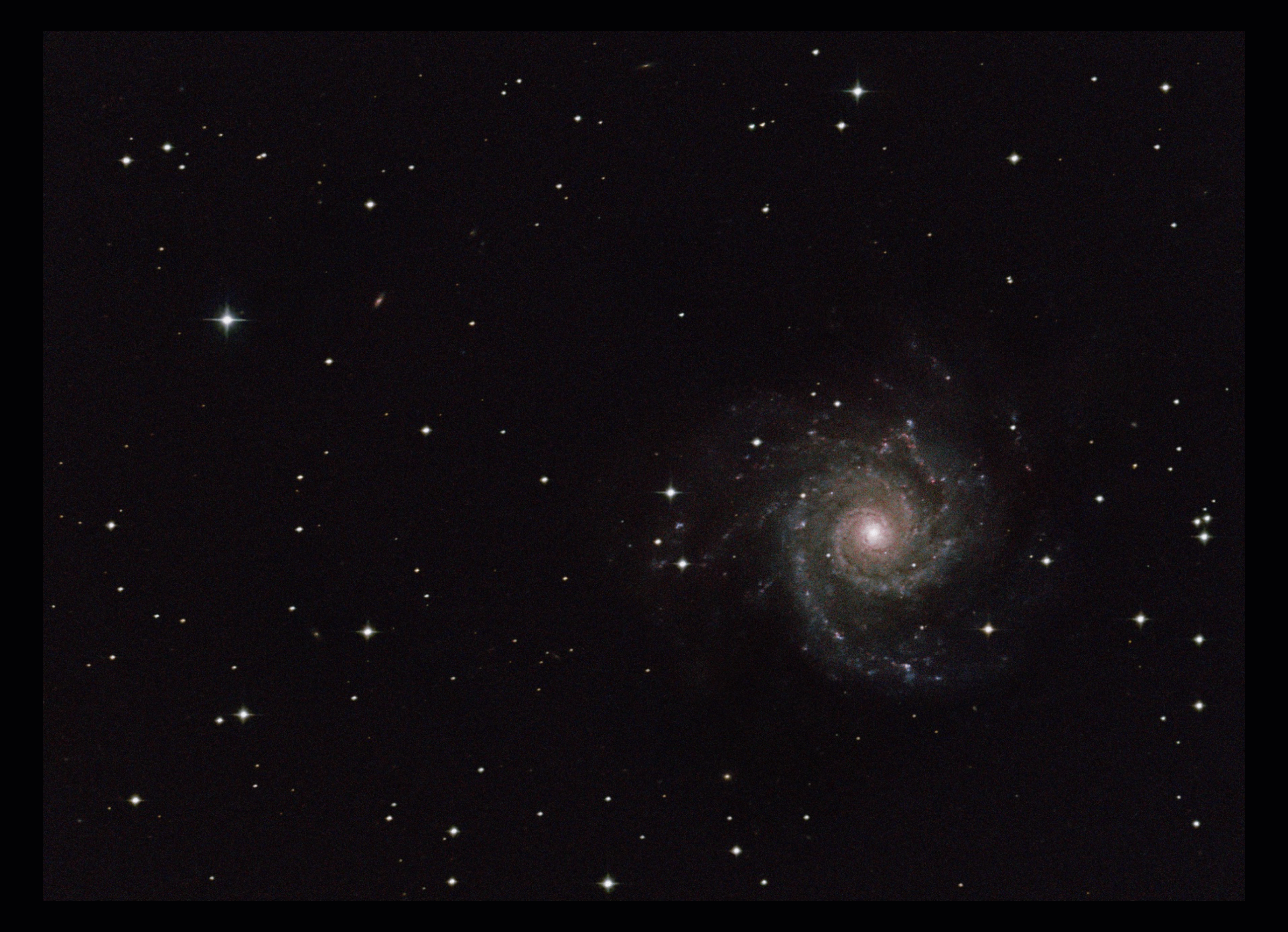
M74 (NGC 628) the "Phantom" Galaxy
Ryan Kinnett, Jan Ludwinski, Candace Dougherty, and John Faulkner
M74 appears bright and obvious in the image above, yet viewed through the eyepiece, it can be a difficult challenge. In the entirety of the Messier catalog, it has the second lowest surface brightness (only M101 is dimmer) and hence is worthy of the moniker "Phantom." From the dark skies of 18th century France, it was nevertheless detected by Messier's collaborator Pierre Méchain who first spotted it in 1780.
The galaxy, some 32 million light-years distant, is "located" in the Zodiac constellation of Pisces, a large patch of sky containing two strings of stars radiating out from a common sun. To each length an imagined fish is attached, thus the name. As the brightest deep-sky and only 'M' object in the constellation, this galaxy can be considered the pride of Pisces.
The image is only a five minute exposure, but the result of the CMOS camera's output invites a closer look. When viewing at full resolution, several identified and suspect galaxies can be glimpsed within the blue circles. Indeed there may be many more.
Galaxies are so plentiful in the cosmos that "deep," ultra-long exposure images show that their numbers rival or perhaps outnumber the foreground stars of our own galaxy wihin that same field of view. The Hubble Space Telescope demonstrated this surprising fact many years ago.

M74 (NGC 628) the "Phantom" Galaxy
Ryan Kinnett, Jan Ludwinski, Candace Dougherty, and John Faulkner
M74 appears bright and obvious in the image above, yet viewed through the eyepiece, it can be a difficult challenge. In the entirety of the Messier catalog, it has the second lowest surface brightness (only M101 is dimmer) and hence is worthy of the moniker "Phantom." From the dark skies of 18th century France, it was nevertheless detected by Messier's collaborator Pierre Méchain who first spotted it in 1780.
The galaxy, some 32 million light-years distant, is "located" in the Zodiac constellation of Pisces, a large patch of sky containing two strings of stars radiating out from a common sun. To each length an imagined fish is attached, thus the name. As the brightest deep-sky and only 'M' object in the constellation, this galaxy can be considered the pride of Pisces.
The image is only a five minute exposure, but the result of the CMOS camera's output invites a closer look. When viewing at full resolution, several identified and suspect galaxies can be glimpsed within the blue circles. Indeed there may be many more.
Galaxies are so plentiful in the cosmos that "deep," ultra-long exposure images show that their numbers rival or perhaps outnumber the foreground stars of our own galaxy wihin that same field of view. The Hubble Space Telescope demonstrated this surprising fact many years ago.







